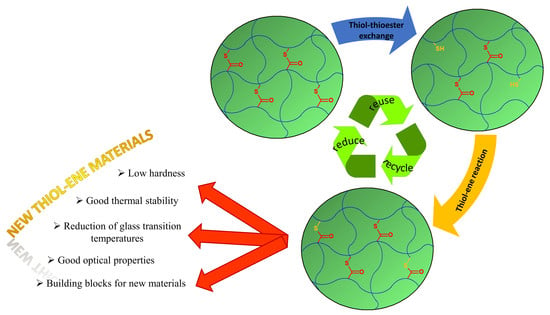Cross-Linked Polythiomethacrylate Esters Based on Naphthalene—Synthesis, Properties and Reprocessing
Abstract
:1. Introduction
2. Materials and Methods
2.1. Materials in Experiments
2.2. Analytical Methods
3. Synthesis of Thiols
3.1. Synthesis of Naphthalene-1,5-Dithiol (1,5-NAF-SH)
3.1.1. Chlorosulfonation of Naphthalene [41]
3.1.2. Reduction of Naphthalene-1,5-Disulfonyl Dichloride
3.2. Synthesis of Naphthalene-1,4(1,5)-Di(Ylmethanethiol) (1,4(1,5)-NAF-CH2SH)
3.2.1. Reaction of Naphthalene with Paraformaldehyde
3.2.2. Reaction of 1,4(1,5)-Bis(Chloromethyl)Naphthalene with Thiourea
4. General Procedure for the Methacrylation of Thiols
5. Polymerization Reactions
6. The Thiol-Thioester Exchange
7. Thiol-ene Reactions with 2-Hydroxyethyl Methacrylate
8. Results and Discussion
8.1. The ATR/FT-IR Spectra of Thiols and Thioesters
8.2. The ATR/FT-IR Spectra of MMA and ST Copolymers
8.3. Conversion of Unsaturated Bonds
8.4. DSC Analysis
8.5. TG/DTG Analysis
8.6. Optical Properties
8.7. Hardness Tests
8.8. The Swelling Studies of Cross-Linked Polymers
8.9. Thiol-Thioester Exchange and Thiol-Methacrylate Modification Reactions
8.9.1. ATR/FT-IR Analysis
8.9.2. Studies of Hardness and Swelling of Materials After Thiol-Ene Reactions
8.9.3. DSC Study
9. Conclusions
Supplementary Materials
Author Contributions
Funding
Conflicts of Interest
References
- Naga, N.; Tanaka, H.; Moriyama, K. Synthesis of network polymers from multifunctional aromatic thiol compounds. J. Electrochem. Soc. 2019, 166, B3079–B3083. [Google Scholar] [CrossRef]
- Moad, G.; Solomon, D.H. The Chemistry of Free Radical Polymerization, 2nd ed.; Elsevier: Oxford, UK, 2006. [Google Scholar]
- Wu, J.; Li, P.; Ma, X.; Liang, Q.; Yuan, T.; Ma, G. Synthesis and characterization of polyacrylate composite with thiol-modified nanosilica as chain transfer agent. J. Appl. Polym. Sci. 2015, 132, 1–6. [Google Scholar] [CrossRef]
- Karasu, F.; Arsu, N.; Yagci, Y. 2-Mercapto thioxanthone as a chain transfer agent in free-radical polymerization: A versatile route to incorporate thioxanthone moieties into polymer chain-ends. J. Appl. Polym. Sci. 2007, 103, 3766–3770. [Google Scholar] [CrossRef]
- Ito, O.; Matsuda, M. Evaluation of Addition Rates of Thiyl Radicals to Vinyl Monomers by Flash Photolysis. 3. Polar Effect in Addition Reactions of Substituted Benzenethiyl Radicals. J. Am. Chem. Soc. 1981, 103, 5871–5874. [Google Scholar] [CrossRef]
- Cokbaglan, L.; Arsu, N.; Yagci, Y.; Jockusch, S.; Turro, N.J. 2-Mercaptothioxanthone As a Novel Photoinitiator for Free Radical Polymerization. Macromolecules 2003, 36, 2649–2653. [Google Scholar] [CrossRef]
- Henríquez, C.; Bueno, C.; Lissi, E.A.; Encinas, M.V. Thiols as chain transfer agents in free radical polymerization in aqueous solution. Polymer 2003, 44, 5559–5561. [Google Scholar] [CrossRef]
- Valdebenito, A.; Encinas, M.V. Thiophenols as chain transfer agents in the polymerization of vinyl monomers. Polymer 2005, 46, 10658–10662. [Google Scholar] [CrossRef]
- Krongauz, V.V.; Chawla, C.P. Revisiting aromatic thiols effects on radical photopolymerization. Polymer 2003, 44, 3871–3876. [Google Scholar] [CrossRef]
- Kolb, H.C.; Finn, M.G.; Sharpless, K.B. Click Chemistry: Diverse Chemical Function from a Few Good Reactions. Angew. Chem. Int. Ed. Engl. 2001, 40, 2004–2021. [Google Scholar] [CrossRef]
- Lowe, A.B. Thiol-ene “click” reactions and recent applications in polymer and materials synthesis: A first update. Polym. Chem. 2014, 5, 4820–4870. [Google Scholar] [CrossRef]
- Hoyle, C.E.; Bowman, C.N. Thiol-ene click chemistry. Angew. Chem. Int. Ed. 2010, 49, 1540–1573. [Google Scholar] [CrossRef] [PubMed]
- Northrop, B.H.; Coffey, R.N. Thiol−ene click chemistry: Computational and kinetic analysis of the influence of alkene functionality. J. Am. Chem. Soc. 2012, 134, 13804–13817. [Google Scholar] [CrossRef] [PubMed]
- David, R.L.A.; Kornfield, J.A. Facile, efficient routes to diverse protected thiols and to their deprotection and addition to create functional polymers by thiol-ene coupling. Macromolecules 2008, 41, 1151–1161. [Google Scholar] [CrossRef] [Green Version]
- Hoyle, C.E.; Lowe, A.B.; Bowman, C.N. Thiol-click chemistry: A multifaceted toolbox for small molecule and polymer synthesis. Chem. Soc. Rev. 2010, 39, 1355–1387. [Google Scholar] [CrossRef] [PubMed]
- Kumar, R.; Shard, A.; Andhare, N.H.; Richa; Sinha, A.K. Thiol-ene “click” reaction triggered by neutral ionic liquid: The “ambiphilic” character of [hmim]Br in the regioselective nucleophilic hydrothiolation. Angew. Chem. Int. Ed. 2015, 54, 828–832. [Google Scholar] [CrossRef]
- Sinha, A.K.; Equbal, D. Thiol−Ene Reaction: Synthetic Aspects and Mechanistic Studies of an Anti-Markovnikov-Selective Hydrothiolation of Olefins. Asian J. Org. Chem. 2019, 8, 32–47. [Google Scholar] [CrossRef]
- Tucker-Schwartz, A.K.; Farrell, R.A.; Garrell, R.L. Thiol-Ene click reaction as a general route to functional trialkoxysilanes for surface coating applications. J. Am. Chem. Soc. 2011, 133, 11026–11029. [Google Scholar] [CrossRef]
- Goddard-Borger, E.D.; Tropak, M.B.; Yonekawa, S.; Tysoe, C.; Mahuran, D.J.; Withers, S.G. Rapid Assembly of a Library of Lipophilic Iminosugars via the Thiol−Ene Reaction Yields Promising Pharmacological Chaperones for the Treatment of Gaucher Disease. J. Med. Chem. 2012, 55, 2737–2745. [Google Scholar] [CrossRef]
- Kanagasabapathy, S.; Sudalai, A.; Benicewicz, B.C. Montmorillonite K 10-catalyzed regioselective addition of thiols and thiobenzoic acids onto olefins: An efficient synthesis of dithiocarboxylic esters. Tetrahedron Lett. 2001, 42, 3791–3794. [Google Scholar] [CrossRef]
- Goldmann, A.S.; Walther, A.; Nebhani, L.; Joso, R.; Ernst, D.; Loos, K.; Barner-Kowollik, C.; Earner, L.; Müller, A.H.E. Surface modification of poly(divinylbenzene) microspheres via thiol-ene chemistry and alkyne-azide click reactions. Macromolecules 2009, 42, 3707–3714. [Google Scholar] [CrossRef] [Green Version]
- Hoyle, C.E.; Lee, T.Y.; Roper, T. Thiol-enes: Chemistry of the past with promise for the future. J. Polym. Sci. Part A Polym. Chem. 2004, 42, 5301–5338. [Google Scholar] [CrossRef]
- Vandenbergh, J.; Peeters, M.; Kretschmer, T.; Wagner, P.; Junkers, T. Cross-linked degradable poly(β-thioester) networks via amine-catalyzed thiol-ene click polymerization. Polymer 2014, 55, 3525–3532. [Google Scholar] [CrossRef] [Green Version]
- Gress, A.; Völkel, A.; Schlaad, H. Thio-click modification of poly[2 -(3-butenyl)-2-oxazoline]. Macromolecules 2007, 40, 7928–7933. [Google Scholar] [CrossRef]
- Chan, J.W.; Hoyle, C.E.; Lowe, A.B. Sequential phosphine-catalyzed, nucleophilic thiol ene/radical-mediated thiol-yne reactions and the facile orthogonal synthesis of polyfunctional materials. J. Am. Chem. Soc. 2009, 131, 5751–5753. [Google Scholar] [CrossRef]
- Mather, B.D.; Viswanathan, K.; Miller, K.M.; Long, T.E. Michael addition reactions in macromolecular design for emerging technologies. Prog. Polym. Sci. 2006, 31, 487–531. [Google Scholar] [CrossRef]
- Gimbert, C.; Moreno-Mañas, M.; Pérez, E.; Vallribera, A. Tributylphosphine, excellent organocatalyst for conjugate additions of non-nucleophilic N-containing compounds. Tetrahedron 2007, 63, 8305–8310. [Google Scholar] [CrossRef]
- Kloxin, C.J.; Bowman, C.N. Covalent adaptable networks: Smart, reconfigurable and responsive network systems. Chem. Soc. Rev. 2013, 42, 7161–7173. [Google Scholar] [CrossRef] [Green Version]
- Montarnal, D.; Capelot, M.; Tournilhac, F.; Leibler, L. Silica-like malleable materials from permanent organic networks. Science 2011, 334, 965–968. [Google Scholar] [CrossRef]
- Yu, K.; Taynton, P.; Zhang, W.; Dunn, M.L.; Qi, H.J. Reprocessing and recycling of thermosetting polymers based on bond exchange reactions. RSC Adv. 2014, 4, 10108–10117. [Google Scholar] [CrossRef]
- Lu, Y.X.; Tournilhac, F.; Leibler, L.; Guan, Z. Making insoluble polymer networks malleable via olefin metathesis. J. Am. Chem. Soc. 2012, 134, 8424–8427. [Google Scholar] [CrossRef]
- Rekondo, A.; Martin, R.; Ruiz De Luzuriaga, A.; Cabañero, G.; Grande, H.J.; Odriozola, I. Catalyst-free room-temperature self-healing elastomers based on aromatic disulfide metathesis. Mater. Horiz. 2014, 1, 237–240. [Google Scholar] [CrossRef]
- Denissen, W.; Winne, J.M.; Du Prez, F.E. Vitrimers: Permanent organic networks with glass-like fluidity. Chem. Sci. 2016, 7, 30–38. [Google Scholar] [CrossRef] [PubMed] [Green Version]
- Taynton, P.; Yu, K.; Shoemaker, R.K.; Jin, Y.; Qi, H.J.; Zhang, W. Heat- or water-driven malleability in a highly recyclable covalent network polymer. Adv. Mater. 2014, 26, 3938–3942. [Google Scholar] [CrossRef] [PubMed]
- Cromwell, O.R.; Chung, J.; Guan, Z. Malleable and self-healing covalent polymer networks through tunable dynamic boronic ester bonds. J. Am. Chem. Soc. 2015, 137, 6492. [Google Scholar] [CrossRef]
- Worrell, B.T.; McBride, M.K.; Lyon, G.B.; Cox, L.M.; Wang, C.; Mavila, S.; Lim, C.H.; Coley, H.M.; Musgrave, C.B.; Ding, Y.; et al. Bistable and photoswitchable states of matter. Nat. Commun. 2018, 9, 2804. [Google Scholar] [CrossRef] [Green Version]
- McBride, M.K.; Worrell, B.T.; Brown, T.; Cox, L.M.; Sowan, N.; Wang, C.; Podgorski, M.; Martinez, A.M.; Bowman, C.N. Enabling Applications of Covalent Adaptable Networks. Annu. Rev. Chem. Biomol. Eng. 2019, 10, 175–198. [Google Scholar] [CrossRef]
- Wang, C.; Mavila, S.; Worrell, B.T.; Xi, W.; Goldman, T.M.; Bowman, C.N. Productive Exchange of Thiols and Thioesters to Form Dynamic Polythioester-Based Polymers. ACS Macro Lett. 2018, 7, 1312–1316. [Google Scholar] [CrossRef]
- Lekishvili, N.; Nadareishvili, L.; Zaikov, G.; Khananashvili, L. Polymers and Polymeric Materials for Fiber and Gradient Optics; VSP BV: Oud-Beijerland, The Netherlands, 2002. [Google Scholar]
- Goseki, R.; Ishizone, T. Encyclopedia of Polymeric Nanomaterials. Encycl. Polym. Nanomater. 2014, 1–11. [Google Scholar] [CrossRef]
- Ralph, M.; Swisher, R.D. Preparation of 1,5-Naphthalene Disulfonyl Chloride. U.S. Patent 2,827,487, 18 May 1958. [Google Scholar]
- Caesar, P.D. Naphthalene-1,5-disulfonyl chloride. Org. Synth. 1963, 4, 693–694. [Google Scholar] [CrossRef]
- Marvel, C.S.; Caesar, P.D. Polyarylene-Alkylene Sulfides. J. Am. Chem. Soc. 1951, 73, 1097–1099. [Google Scholar] [CrossRef]
- Lock, G.; Schneider, R. Uber die Chlormethylierung des Naphthalins, 11. Mitteil.: 1.4- und 1.5-Di-chlormethyl-naphthalin. Chem. Ber. 1951, 84, 636–641. [Google Scholar] [CrossRef]
- Murahaski, S.; Matsukowa, H. No Title. Bull. Inst. Phys. Chem. Res. 1942, 71, 509. [Google Scholar]
- Bagder, G.M.; Cook, J.W.; Crosbie, G.W. The chloromethylation of naphthalene and of tetralin. J. Chem. Soc. 1947, 1432–1434. [Google Scholar]
- Podkościelny, W.; Charmas, W. Linear Polythioesters. II. Products of interfacial polycondensation of 1,4-di (mercaptomethyl)-naphthalene, 1,5-di (mercaptomethyl)-naphthalene, and a mixture of 1,4- and 1,5-di(mercaptornethyl)-naphthalene with terephthaloyl and isophthaloyl chlorides. J. Polym. Sci. Polym. Chem. Ed. 1979, 17, 2429–2438. [Google Scholar] [CrossRef]
- Fila, K.; Goliszek, M.; Podkościelna, B.; Podgórski, M. Polymer side-chain modification in methacrylate and styrene copolymers through thiol-thioester dynamic exchange. Eur. Polym. J. (Under Review) 2020. [Google Scholar]
- Koo, S.P.S.; Stamenović, M.M.; Arun Prasath, R.; Inglis, A.J.; Prez, F.E.D.U.; Barner-Kowollik, C.; Van Camp, W.I.M.; Junkers, T. Limitations of radical thiol-ene reactions for polymer-polymer conjugation. J. Polym. Sci. Part A Polym. Chem. 2010, 48, 1699–1713. [Google Scholar] [CrossRef] [Green Version]
- Illy, N.; Robitzer, M.; Auvergne, R.; Caillol, S.; David, G.; Boutevin, B. Synthesis of water-soluble allyl-functionalized oligochitosan and its modification by thiol-ene addition in water. J. Polym. Sci. Part A Polym. Chem. 2014, 52, 39–48. [Google Scholar] [CrossRef]
- Way, D.V.; Barbosa, P.I.T.R.; Pinto, J.C. On some practical aspects of click thiol-ene reactions for polymer modification and conjugation with biomolecules. Glob. J. Pure Appl. Chem. Res. 2018, 6, 9–40. [Google Scholar] [CrossRef]
- Campos, L.M.; Killops, K.L.; Sakai, R.; Paulusse, J.M.J.; Damiron, D.; Drockenmuller, E.; Messmore, B.W.; Hawker, C.J. Development of thermal and photochemical strategies for thiol-ene click polymer functionalization. Macromolecules 2008, 41, 7063–7070. [Google Scholar] [CrossRef]
- Lee, T.Y.; Smith, Z.; Reddy, S.K.; Cramer, N.B.; Bowman, C.N. Thiol-allyl ether-methacrylate ternary systems. Polymerization mechanism. Macromolecules 2007, 40, 1466–1472. [Google Scholar] [CrossRef]
- Okamura, H.; Yamagaki, M.; Nakata, K. Analysis of network structures in thiol-ene UV curing system using reworkable resins. Polymers 2018, 11, 5. [Google Scholar] [CrossRef] [PubMed] [Green Version]
- Cramer, N.B.; Couch, C.L.; Schreck, K.M.; Carioscia, J.A.; Boulden, J.E.; Stansbury, J.W.; Bowman, C.N. Investigation of thiol-ene and thiol-ene-methacrylate based resins as dental restorative materials. Dent. Mater. 2010, 26, 21–28. [Google Scholar] [CrossRef] [PubMed] [Green Version]
- Fila, K.; Grochowicz, M.; Podkościelna, B. Thermal and spectral analysis of copolymers with sulphur groups. J. Therm. Anal. Calorim. 2018, 133, 489–497. [Google Scholar] [CrossRef] [Green Version]
- Rieger, J. The glass transition temperature of polystyrene. J. Therm. Anal. Calorim. 1996, 46, 965–972. [Google Scholar] [CrossRef]
- Olson, B.G.; Peng, Z.L.; Srithawatpong, R.; McGervey, J.D.; Ishida, H.; Jamieson, A.M.; Manias, E.; Giannelis, E.P. Free volume in layered organosilicate-polystyrene nanocomposites. Mater. Sci. Forum 1997, 255–257, 336–338. [Google Scholar] [CrossRef]
- Gałka, P.; Kowalonek, J.; Kaczmarek, H. Thermogravimetric analysis of thermal stability of poly(methyl methacrylate) films modified with photoinitiators. J. Therm. Anal. Calorim. 2014, 115, 1387–1394. [Google Scholar] [CrossRef] [Green Version]
- Saladino, M.L.; Motaung, T.E.; Luyt, A.S.; Spinella, A.; Nasillo, G.; Caponetti, E. The effect of silica nanoparticles on the morphology, mechanical properties and thermal degradation kinetics of PMMA. Polym. Degrad. Stab. 2012, 97, 452–459. [Google Scholar] [CrossRef] [Green Version]
- Kashiwagi, T.; Brown, J.E.; Inaba, A.; Hatada, K.; Kitayama, T.; Masuda, E. Effects of Weak Linkages on the Thermal and Oxidative Degradation of Poly(methyl methacrylates). Macromolecules 1986, 19, 2160–2168. [Google Scholar] [CrossRef]
- Mansour, S.A. Study of thermal stabilization for polystyrene/carbon nanocomposites via TG/DSC techniques. J. Therm. Anal. Calorim. 2013, 112, 579–583. [Google Scholar] [CrossRef]
- You, N.H.; Higashihara, T.; Yasuo, S.; Ando, S.; Ueda, M. Synthesis of sulfur-containing poly(thioester)s with high refractive indices and high Abbe numbers. Polym. Chem. 2010, 1, 480–484. [Google Scholar] [CrossRef]
- Song, S.; Zhang, Z.; Liu, X.; Fu, Z.; Xu, J.; Fan, Z. Synthesis and characterization of functional polyethylene with regularly distributed thioester pendants via ring-opening metathesis polymerization. J. Polym. Sci. Part A Polym. Chem. 2017, 55, 4027–4036. [Google Scholar] [CrossRef]
- Aksakal, S.; Remzi Becer, C. Poly(thioacrylate)s: Expanding the monomer toolbox of functional polymers. Polym. Chem. 2016, 7, 7011–7018. [Google Scholar] [CrossRef] [Green Version]
- Rogulska, M.; Kultys, A.; Puszka, A. New thermoplastic poly(carbonate-urethane)s based on chain extenders with sulfur atoms. Chem. Pap. 2017, 71, 1195–1204. [Google Scholar] [CrossRef] [PubMed] [Green Version]
- Jha, G.S.; Seshadri, G.; Mohan, A.; Khandal, R.K. Sulfur containing optical plastics and its ophthalmic lenses applications. E-Polymers 2008, 8, 1–27. [Google Scholar] [CrossRef]
- Matsuda, T.; Funae, Y.; Yoshida, M.; Yamamoto, T.; Takaya, T. Optical material of high refractive index resin composed of sulfur-containing aromatic methacrylates. J. Appl. Polym. Sci. 2000, 76, 50–54. [Google Scholar] [CrossRef]
- Matsuda, T.; Funae, Y.; Yoshida, M.; Yamamoto, T. High index optical materials prepared by copolymerization of novel bifunctional thiomethacrylates. J. Macromol. Sci. Part A Pure Appl. Chem. 2000, 37, 239–257. [Google Scholar] [CrossRef]
- Cullity, B.D.; Stock, S.R. Elements of X-ray Diffraction, 3rd ed.; Prentice Hall: Upper Saddle River, NJ, USA, 2001. [Google Scholar]

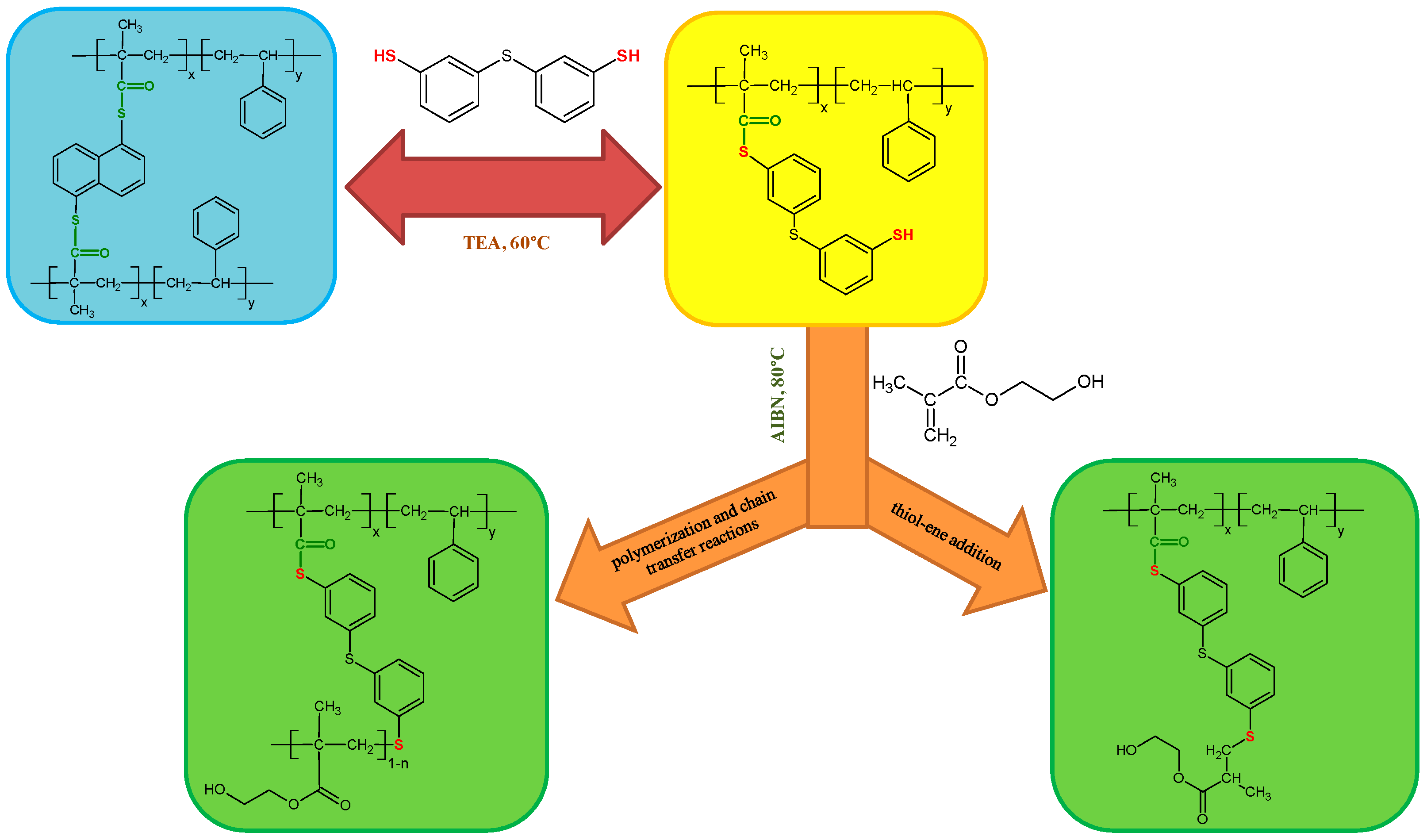
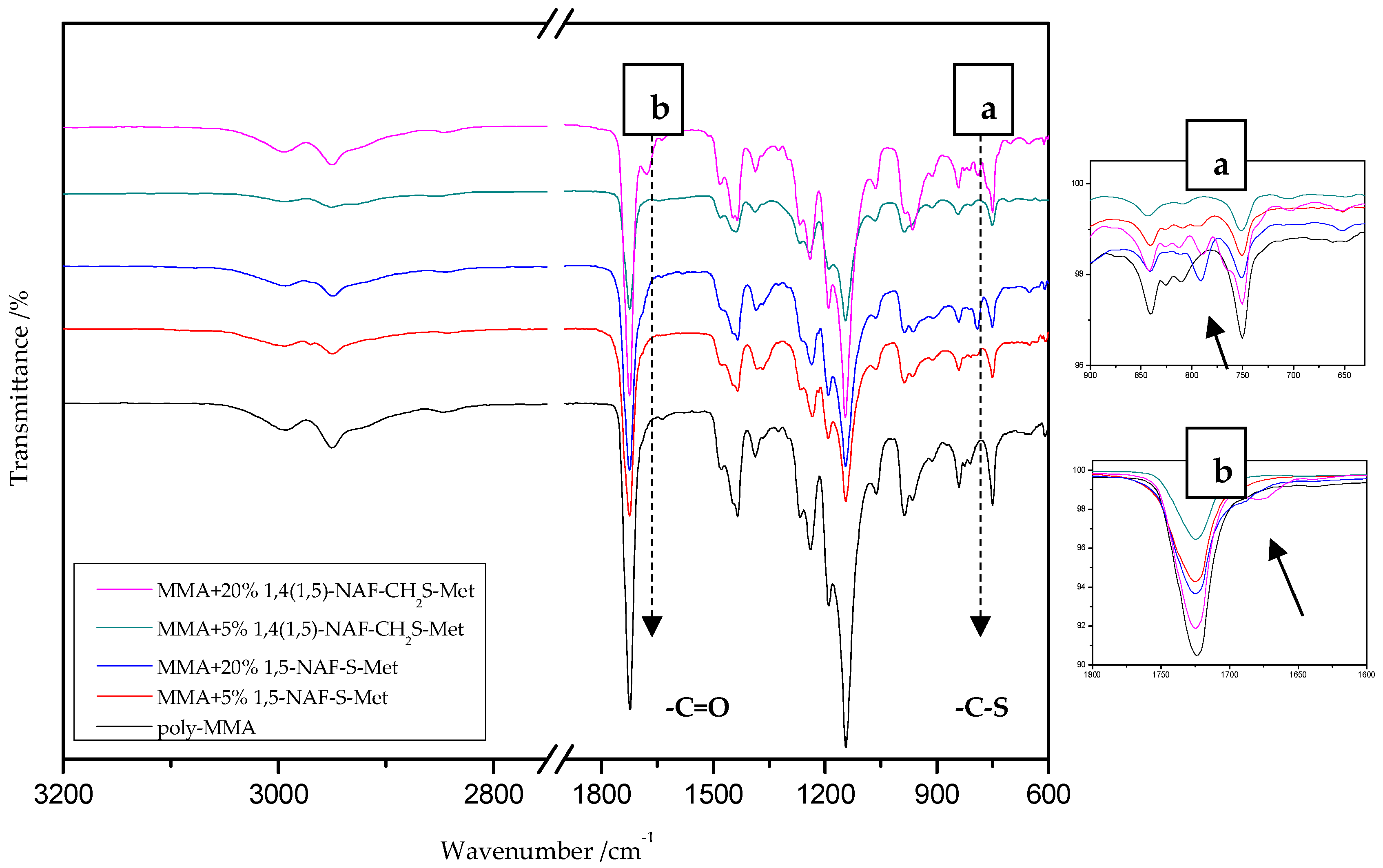
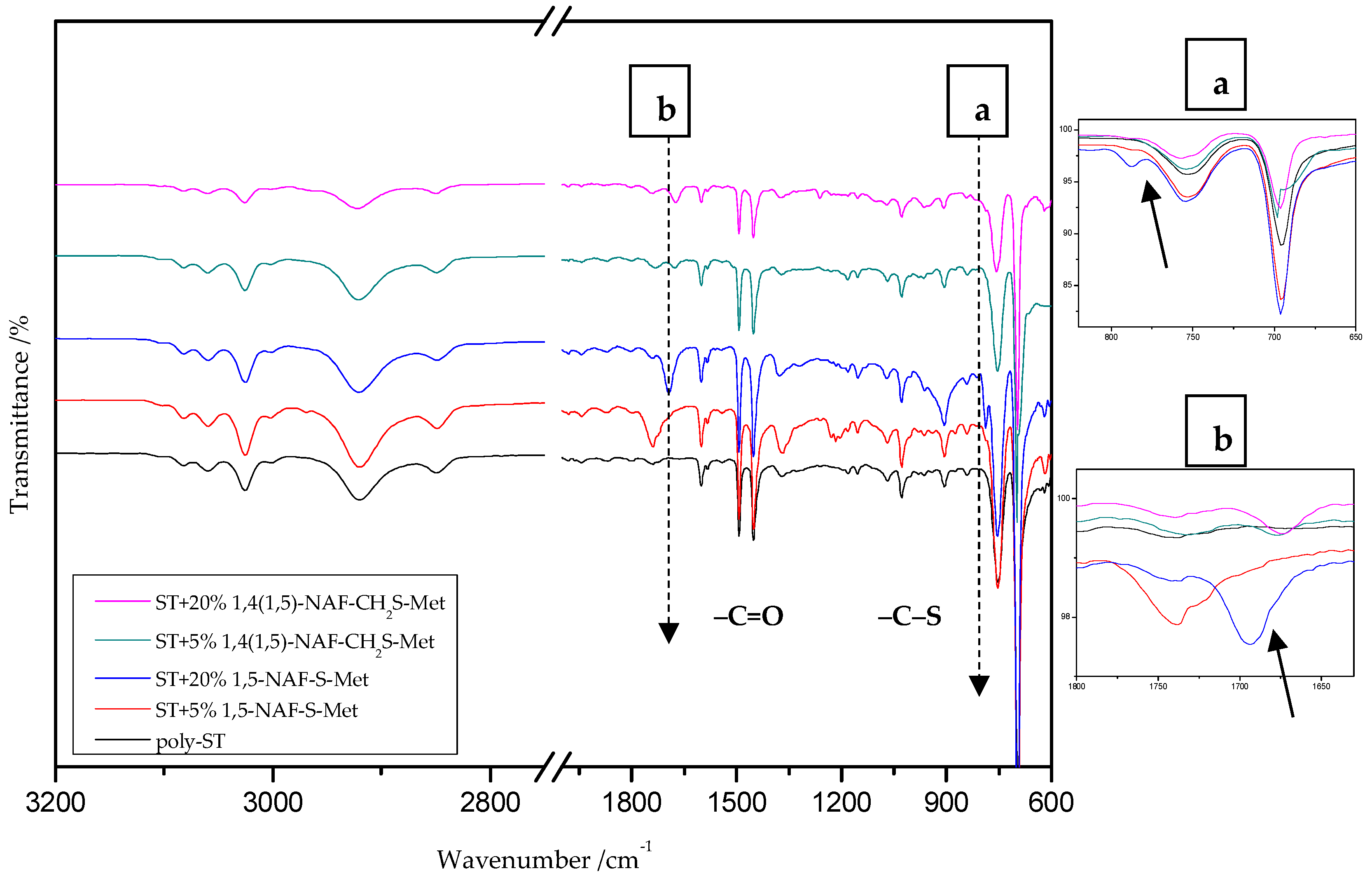

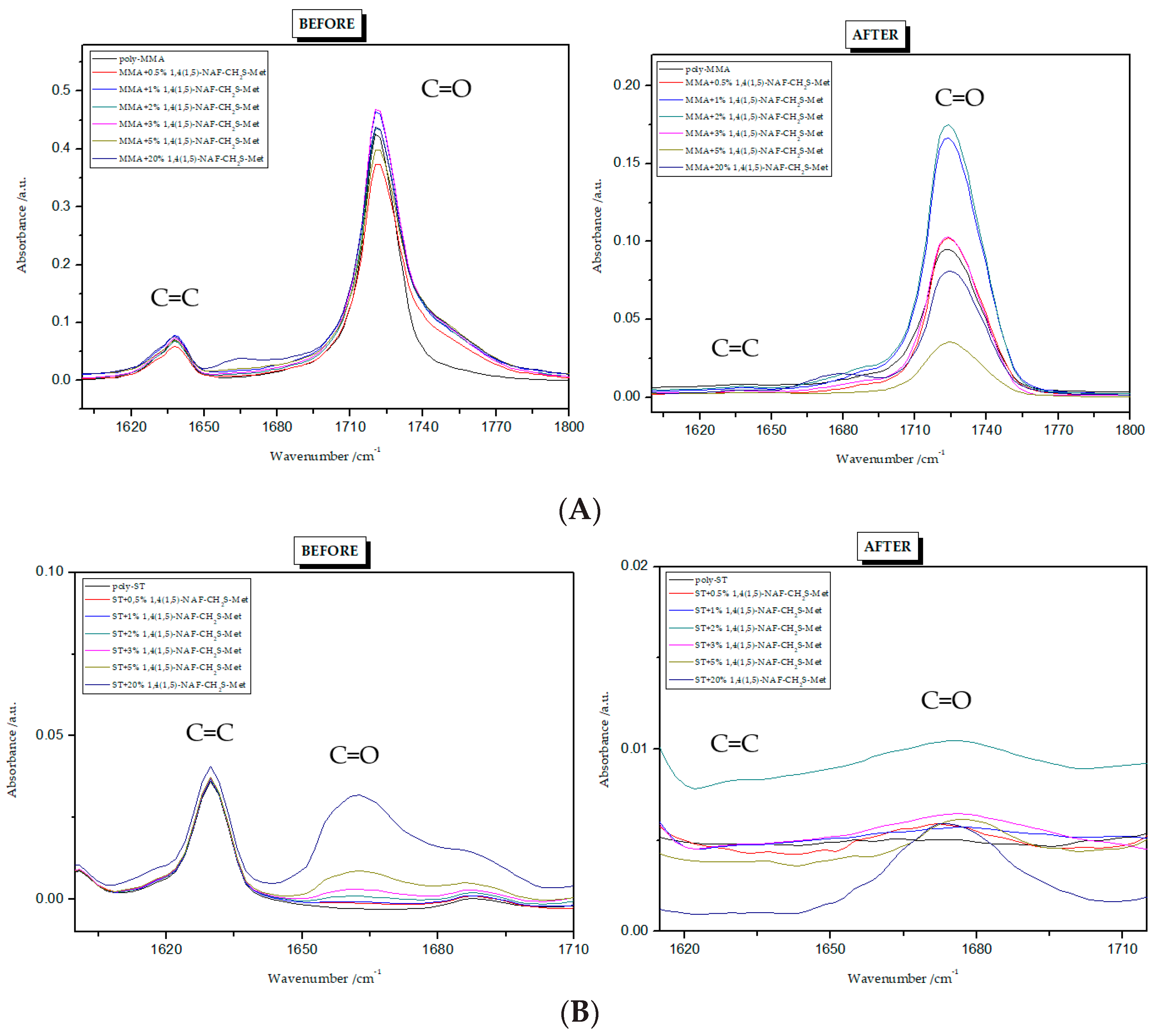
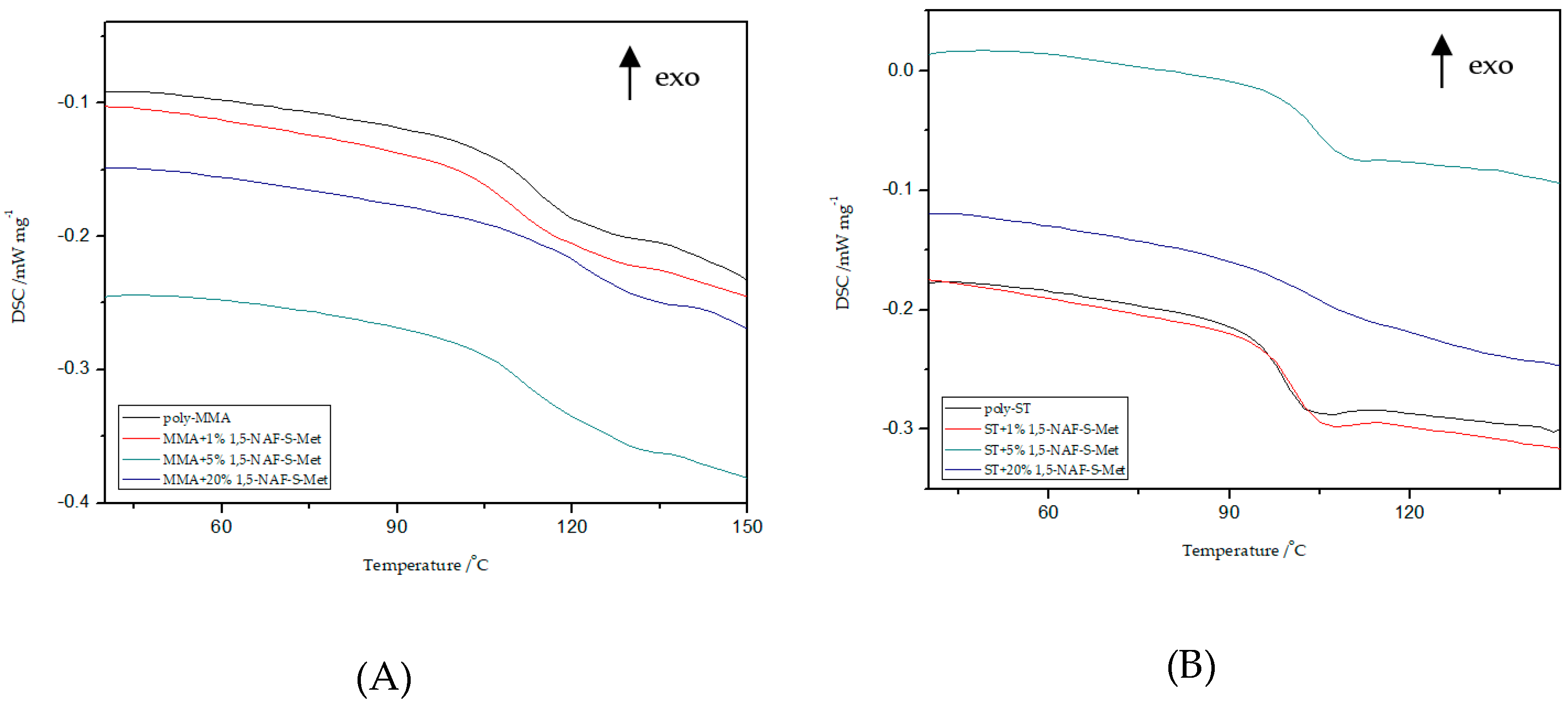
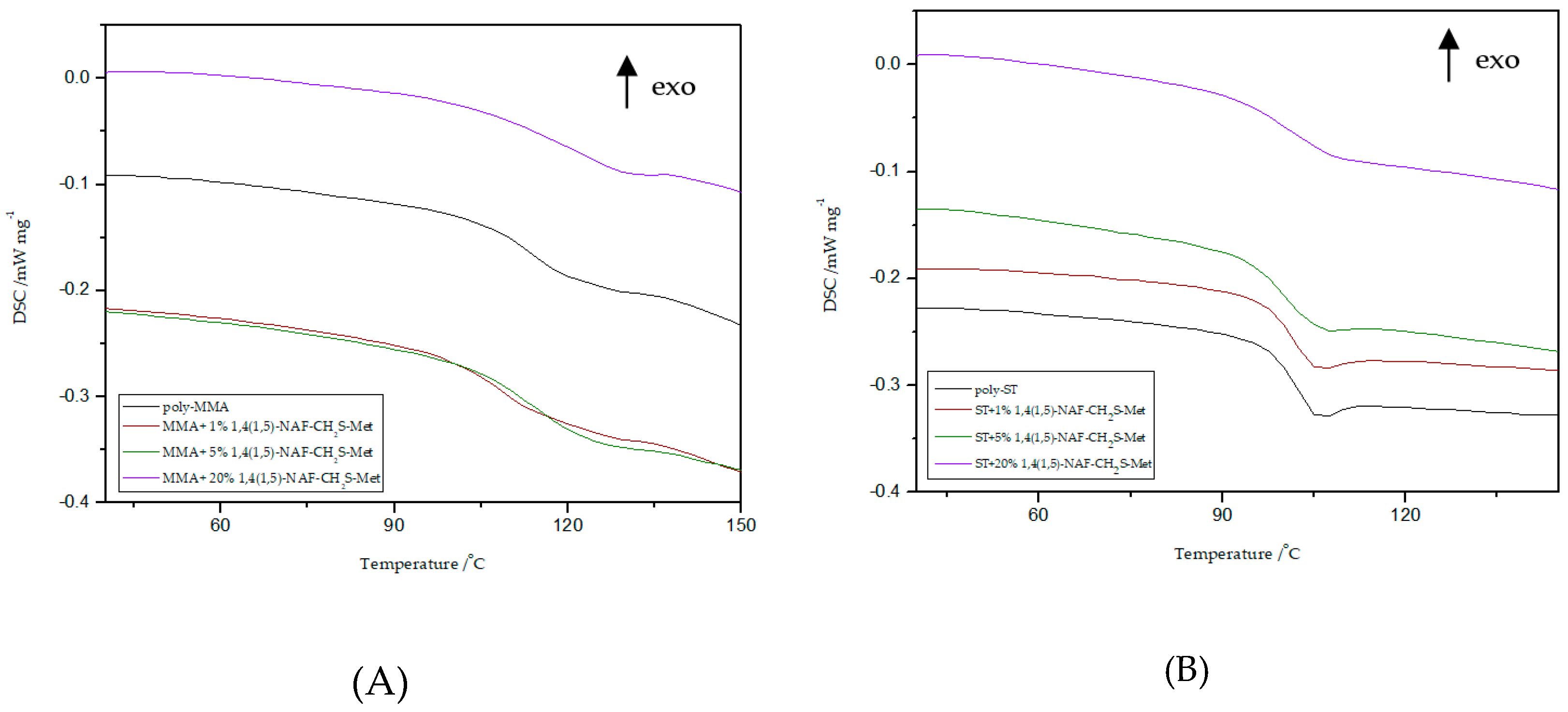
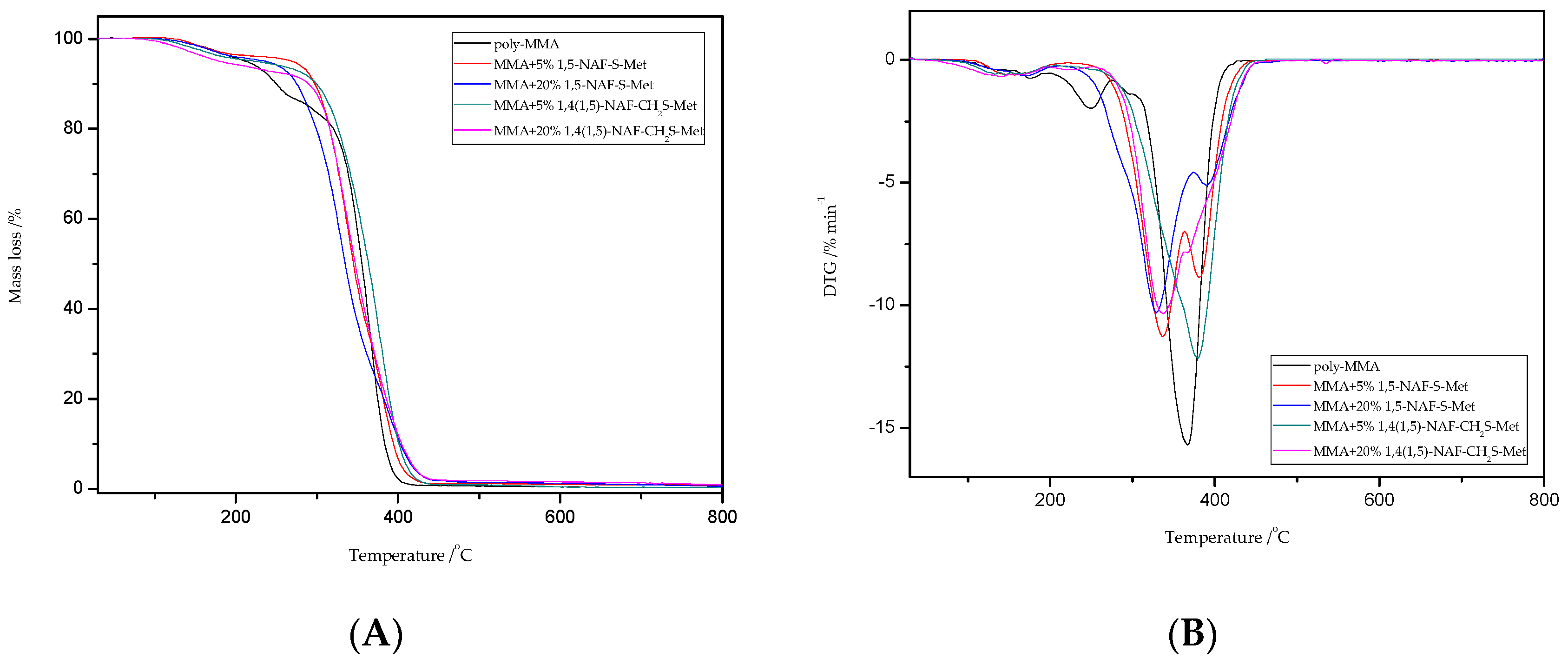


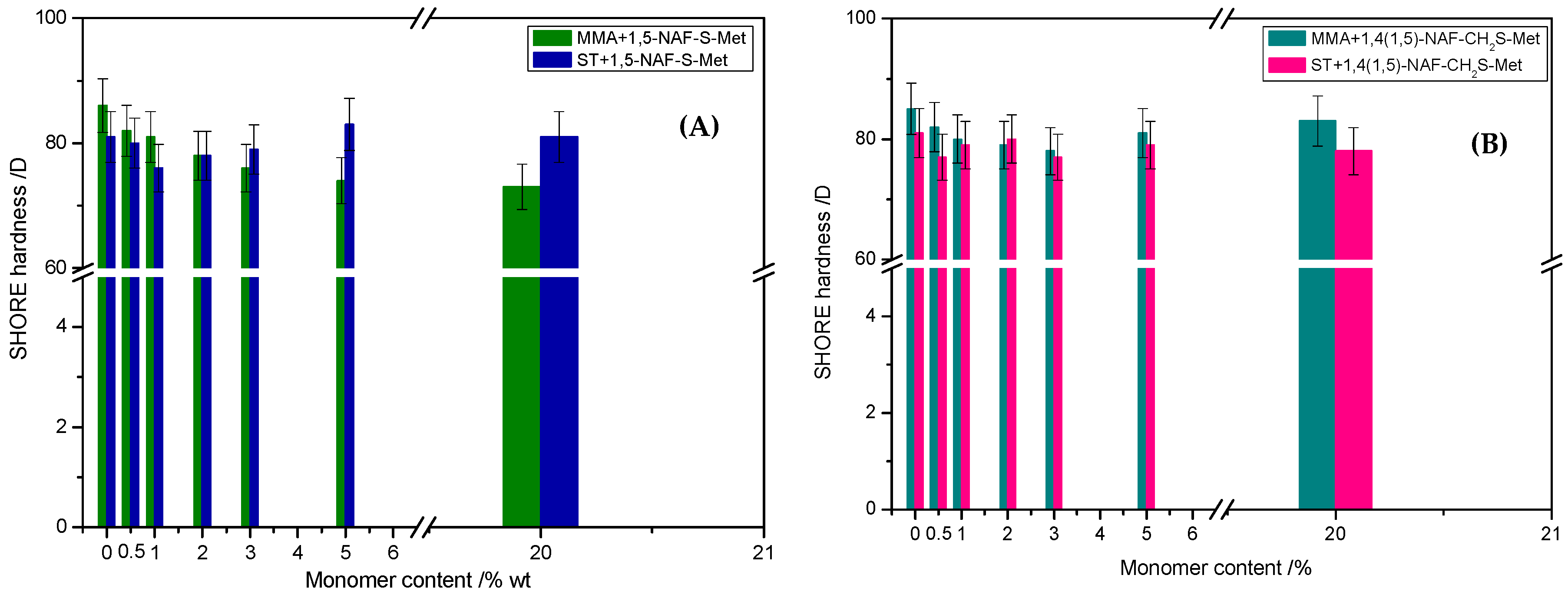


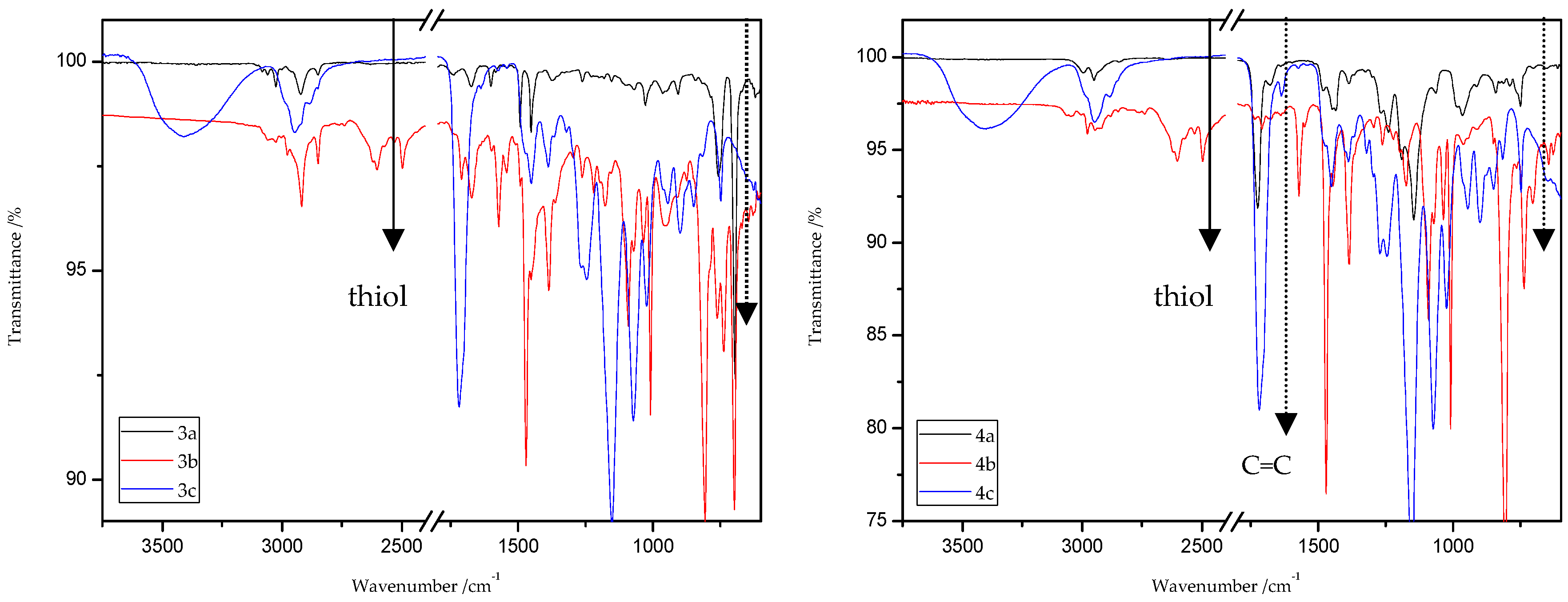
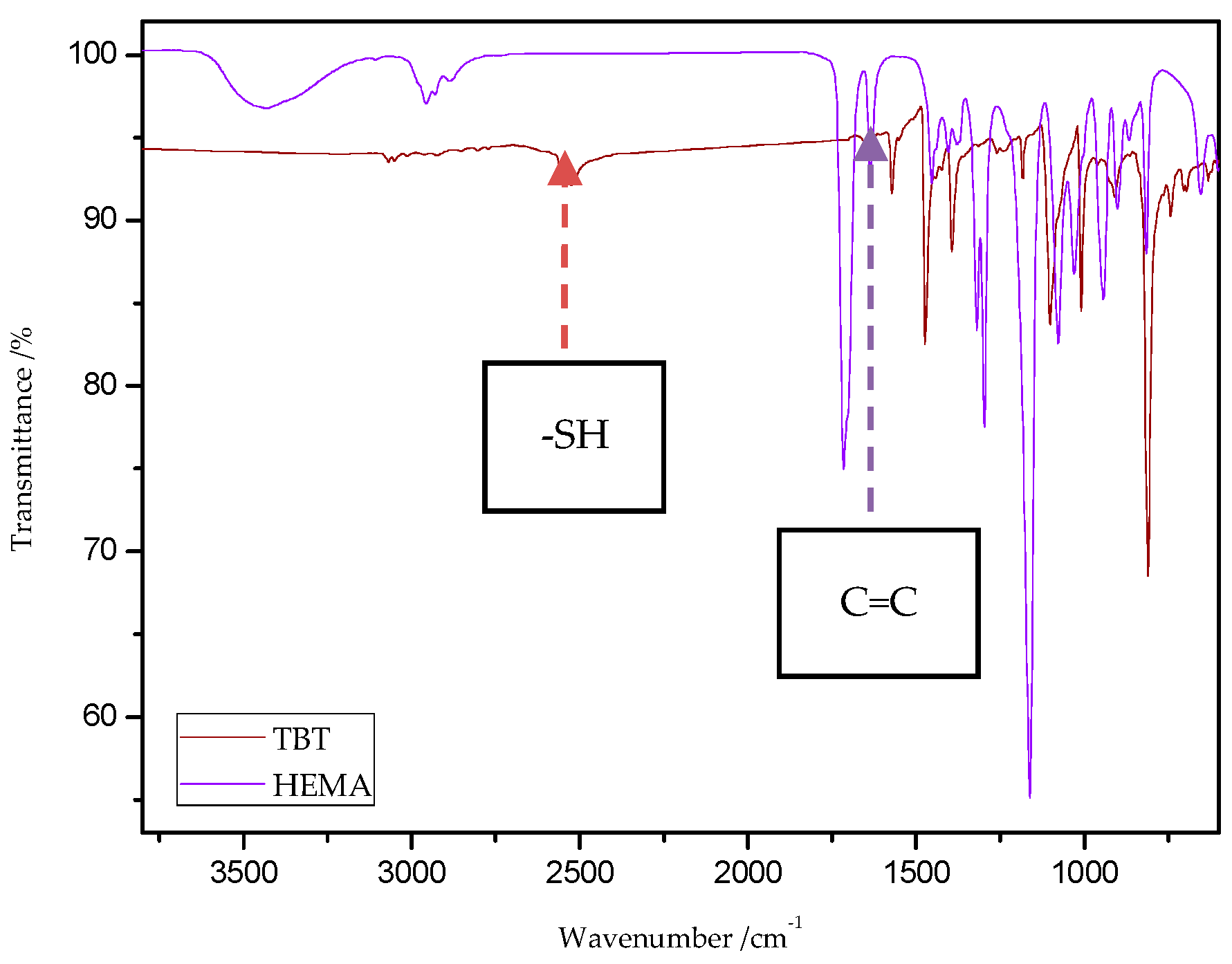
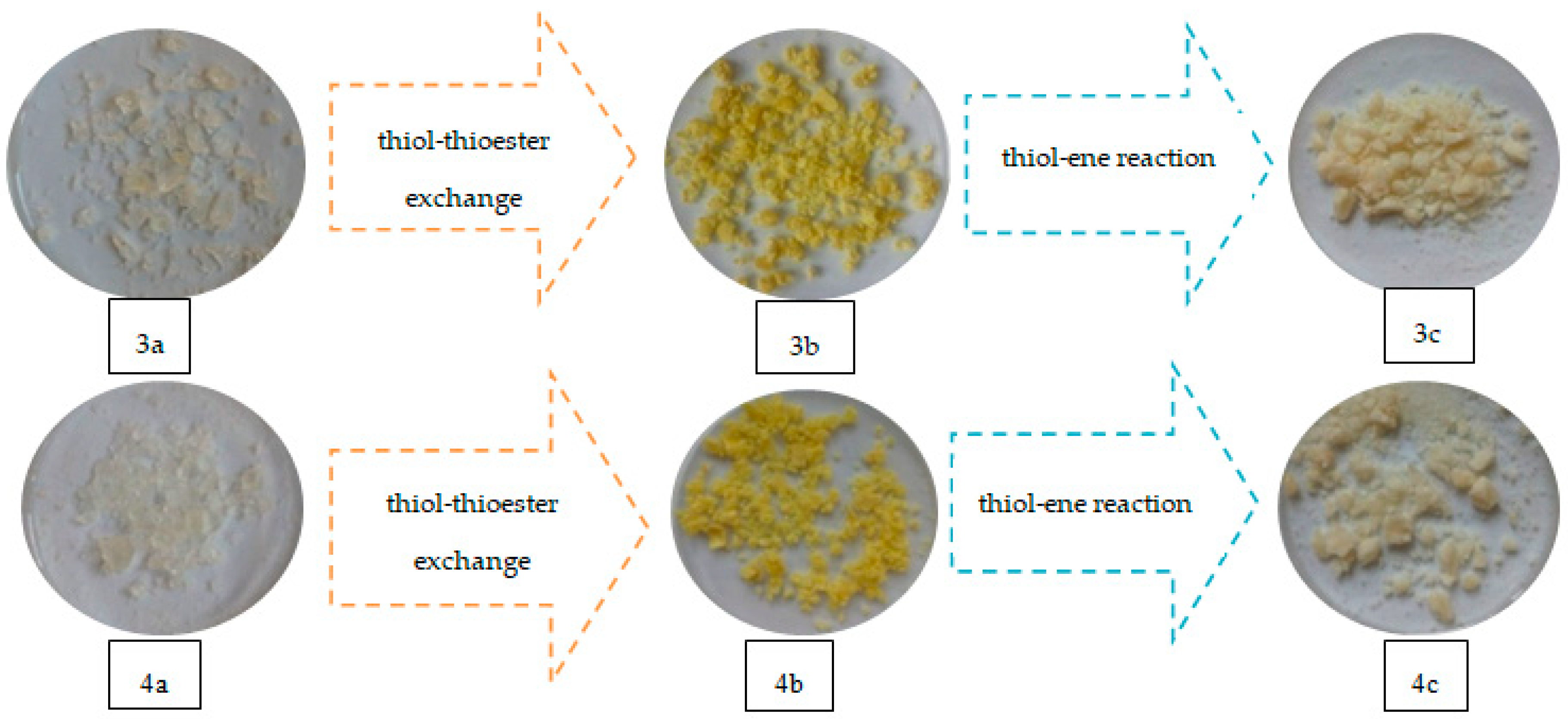
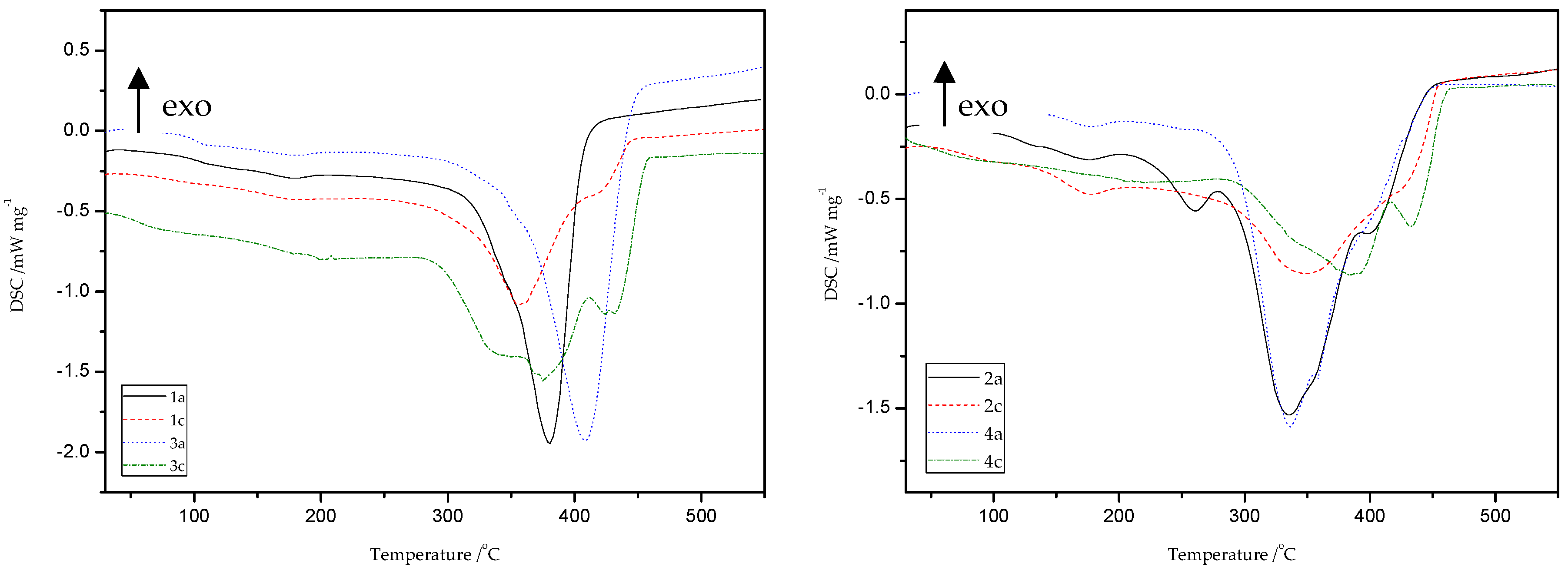
| Thioester Methacrylate | Comonomer | Thioester Monomer—Comonomer Feed Ratios (w/w) | Amount of Sulfur Monomer /g | Amount of Comonomer/g | Yield of Polymerization /% | |
|---|---|---|---|---|---|---|
| MMA Polymers | ST Polymers | |||||
| 1,5-NAF-S-Met | MMA (or ST) | - | - | 2 | 97 | 99 |
| 1:200 | 0.01 | 2 | 97 | 98 | ||
| 1:100 | 0.02 | 2 | 96 | 97 | ||
| 1:50 | 0.04 | 2 | 96 | 96 | ||
| 1:33 | 0.06 | 2 | 95 | 97 | ||
| 1:20 | 0.1 | 2 | 97 | 98 | ||
| 1:5 | 0.4 | 2 | 97 | 98 | ||
| 1,4(1,5)-NAF-CH2S-Met | MMA (or ST) | - | - | 2 | 97 | 99 |
| 1:200 | 0.01 | 2 | 97 | 99 | ||
| 1:100 | 0.02 | 2 | 95 | 97 | ||
| 1:50 | 0.04 | 2 | 96 | 96 | ||
| 1:33 | 0.06 | 2 | 97 | 98 | ||
| 1:20 | 0.1 | 2 | 97 | 99 | ||
| 1:5 | 0.4 | 2 | 95 | 97 | ||
| Material | Simplified Designation of Sample |
|---|---|
| ST+1,5-NAF-S-Met | 1a |
| ST+1,5-NAF-S-Met+TBT | 1b |
| ST+1,5-NAF-S-Met+TBT+HEMA | 1c |
| MMA+1,5-NAF-S-Met | 2a |
| MMA+1,5-NAF-S-Met+TBT | 2b |
| MMA+1,5-NAF-S-Met+TBT+HEMA | 2c |
| ST+1,4(1,5)-NAF-CH2S-Met | 3a |
| ST+1,4(1,5)-NAF-CH2S-Met+TBT | 3b |
| ST+1,4(1,5)-NAF-CH2S-Met+TBT+HEMA | 3c |
| MMA+1,4(1,5)-NAF-CH2S-Met | 4a |
| MMA+1,4(1,5)-NAF-CH2S-Met+TBT | 4b |
| MMA+1,4(1,5)-NAF-CH2S-Met+TBT+HEMA | 4c |
| % w/w 1,5-NAF-S-Met (or 1,4(1,5)-NAF-CH2S-Met) | Degree of Conversion (DC)/% | |||
|---|---|---|---|---|
| ST+1,5-NAF-S-Met | MMA+1,5-NAF-S-Met | ST+1,4(1,5)-NAF-CH2S-Met | MMA+1,4(1,5)-NAF-CH2S-Met | |
| 0 | 100 (-) | 95 (3) | 100 (-) | 95 (3) |
| 0.5 | 100 (-) | 97 (2) | 100 (-) | 96 (2) |
| 1 | 100 (2) | 95 (3) | 99 (1) | 95 (2) |
| 2 | 99 (2) | 96 (2) | 99 (1) | 95 (3) |
| 3 | 99 (1) | 96 (2) | 99 (2) | 94 (3) |
| 5 | 99 (2) | 98 (2) | 99 (2) | 93 (2) |
| 20 | 98 (2) | 97 (3) | 98 (2) | 93 (2) |
| Copolymer | Temperature/ °C | R/% | |||||
|---|---|---|---|---|---|---|---|
| a T2 | b T5 | c T10 | d T50 | e Tf | f Tmax | ||
| poly-MMA | 155 | 240 | 272 | 355 | 435 | 180; 250; 367 | 0.40 |
| MMA + 5% 1,5-NAF-S-Met | 162 | 270 | 298 | 345 | 436 | 157; 337; 381 | 0.69 |
| MMA + 20% 1,5-NAF-S-Met | 161 | 236 | 275 | 335 | 450 | 171; 328; 391 | 1.17 |
| MMA + 5% 1,4(1,5)-NAF-CH2S-Met | 148 | 228 | 285 | 345 | 445 | 149; 346 | 0.90 |
| MMA + 20% 1,4(1,5)-NAF-CH2S-Met | 131 | 181 | 290 | 347 | 460 | 142; 337; 367 | 1.52 |
| poly-ST | 329 | 368 | 384 | 409 | 460 | 414 | 0.26 |
| ST + 5% 1,5-NAF-S-Met | 262 | 341 | 359 | 391 | 440 | 144; 397 | 0.60 |
| ST + 20% 1,5-NAF-S-Met | 158 | 314 | 338 | 375 | 434 | 139; 387 | 1.26 |
| ST + 5% 1,4(1,5)-NAF-CH2S-Met | 253 | 341 | 364 | 402 | 470 | 141; 405 | 0.22 |
| ST + 20% 1,4(1,5)-NAF-CH2S-Met | 168 | 321 | 345 | 396 | 470 | 139; 402 | 0.36 |
| % Thioester | Refractive Index | |||
|---|---|---|---|---|
| ST+1,5-NAF-S-Met | MMA+1,5-NAF-S-Met | ST+1,4(1,5)-NAF-CH2S-Met | MMA+1,4(1,5)-NAF-CH2S-Met | |
| 0 | 1.5440 | 1.4142 | 1.5440 | 1.4142 |
| 0.5 | 1.5448 | 1.4143 | 1.5442 | 1.4142 |
| 1 | 1.5452 | 1.4146 | 1.5445 | 1.4152 |
| 2 | 1.5460 | 1.4153 | 1.5452 | 1.4166 |
| 3 | 1.5470 | 1.4190 | 1.5458 | 1.4196 |
| 5 | 1.5485 | 1.4221 | 1.5470 | 1.4238 |
| 20 | 1.5580 | 1.4473 | 1.5540 | 1.4402 |
| Solvent | Swelling Coefficients, B /% | |||
|---|---|---|---|---|
| After 24 h in Solvent | After 15 Min in Air | After 2 h in Air | After 24 h in Air | |
| ST+20% 1,5-NAF-S-Met | ||||
| THF | 86.1 | 38.8 | 23.5 | 11.0 |
| MeOH | 0.9 | 0.2 | 0.1 | 0.05 |
| ACN | 5.3 | 4.2 | 3.0 | 1.7 |
| Acetone | 29.0 | 22.8 | 17.3 | 8.9 |
| DCM | 83.0 | 34.1 | 11.0 | 1.2 |
| MMA+20% 1,5-NAF-S-Met | ||||
| THF | 1.4 | 0.1 | 0 | 0 |
| MeOH | 3.4 | 2.1 | 1.5 | 0.6 |
| ACN | 16.3 | 12.1 | 9.3 | 3.3 |
| Acetone | 13.0 | 8.7 | 5.8 | 3.2 |
| DCM | 125.6 | 43.8 | 18.3 | 11.1 |
| ST+20% 1,4(1,5)-NAF-CH2S-Met | ||||
| THF | 152.0 | 113.0 | 29.6 | 16.6 |
| MeOH | 0.5 | 0.3 | 0.1 | 0.03 |
| ACN | 3.4 | 3.1 | 2.5 | 0.9 |
| Acetone | 31.8 | 27.0 | 21.2 | 11.7 |
| DCM | 171.4 | 33.7 | 1.9 | 0.4 |
| MMA+20% 1,4(1,5)-NAF-CH2S-Met | ||||
| THF | 1.7 | 0.6 | 0.5 | 0.1 |
| MeOH | 1.4 | 0.9 | 0.4 | 0 |
| ACN | 26.5 | 20.9 | 15.6 | 7.1 |
| Acetone | 11.6 | 6.8 | 3.9 | 2.2 |
| DCM | 149.2 | 30.0 | 7.5 | 1.1 |
| Solvent | Sample | |||
|---|---|---|---|---|
| 1c | 2c | 3c | 4c | |
| Swellability Coefficient, B/% | ||||
| THF | 19 | 43 | 25 | 70 |
| MeOH | 205 | 352 | 114 | 179 |
| ACN | 14 | 45 | 17 | 19 |
| Acetone | 44 | 84 | 41 | 50 |
| DCM | 25 | 55 | 16 | 19 |
| Distilled Water | 93 | 138 | 72 | 90 |
| Sample | DSC Data | ||
|---|---|---|---|
| Tg/°C | Td/°C | ΔHd/J g−1 | |
| 1a | 103 | 380 | 515 |
| 1b | 112 | 354 | 294 |
| 1c | 83 | 356; 413 | 406 |
| 2a | 122 | 261; 336; 398 | 823 |
| 2b | 135 | 302; 338; 353 | 340 |
| 2c | 84 | 349; 422 | 458 |
| 3a | 102 | 408 | 741 |
| 3b | - | 347; 367; 472 | 201 |
| 3c | 105 | 348; 376; 434 | 703 |
| 4a | 120 | 337; 358 | 764 |
| 4b | - | 338; 441 | 253 |
| 4c | 60 | 384; 433 | 432 |
© 2020 by the authors. Licensee MDPI, Basel, Switzerland. This article is an open access article distributed under the terms and conditions of the Creative Commons Attribution (CC BY) license (http://creativecommons.org/licenses/by/4.0/).
Share and Cite
Fila, K.; Podkościelna, B.; Podgórski, M. Cross-Linked Polythiomethacrylate Esters Based on Naphthalene—Synthesis, Properties and Reprocessing. Materials 2020, 13, 3021. https://doi.org/10.3390/ma13133021
Fila K, Podkościelna B, Podgórski M. Cross-Linked Polythiomethacrylate Esters Based on Naphthalene—Synthesis, Properties and Reprocessing. Materials. 2020; 13(13):3021. https://doi.org/10.3390/ma13133021
Chicago/Turabian StyleFila, Karolina, Beata Podkościelna, and Maciej Podgórski. 2020. "Cross-Linked Polythiomethacrylate Esters Based on Naphthalene—Synthesis, Properties and Reprocessing" Materials 13, no. 13: 3021. https://doi.org/10.3390/ma13133021





